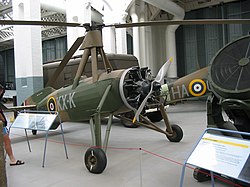Autogyro
An autogyro, also known as a gyroplane, is a type of rotorcraft that uses an unpowered rotor to fly. The autogyro's rotor must have air flowing across the rotor disc to create rotation, and the air flows upwards through the rotor disc and not down. Only one or two people can be on an autogyro.[1]
The autogyro was invented by Spanish engineer Juan de la Cierva to create an aircraft that could fly safely at low speeds. He first flew one on 9 January 1923 in Madrid.[2] Cierva's autogyro is thought to be the predecessor of the modern helicopter.[3][4]
Autogyro Media
The rotor head, pre-rotator shaft, and Subaru engine configuration on a VPM M-16 autogyro
A Cierva C.6 replica in Cuatro Vientos Air Museum, Madrid, Spain
A Focke-Wulf-built Cierva C.19 Mk.IV Autogiro
Buhl A-1 Autogyro with rear push propeller (1931)
Royal Air Force Avro Rota Mk 1 Cierva Autogiro C30 A, at the Imperial War Museum Duxford, UK
References
- ↑ Wragg, David W. (1973). A Dictionary of Aviation (first ed.). Osprey. p. 147. ISBN 9780850451634.
- ↑ Goebel, Greg (1 Jun 2011). "European Helicopter Pioneers". Air Vectors. Archived from the original on 5 February 2012.
{{cite web}}: CS1 maint: unfit URL (link) - ↑ George Galdorisi (2008). Leave No Man Behind: The Saga of Combat Search and Rescue. Voyageur Press. ISBN 978-0-7603-2392-2.
- ↑ Trevor Homer (2007). The Book of Origins: The first of everything. Hachette Digital. ISBN 978-1-405-51610-5.








